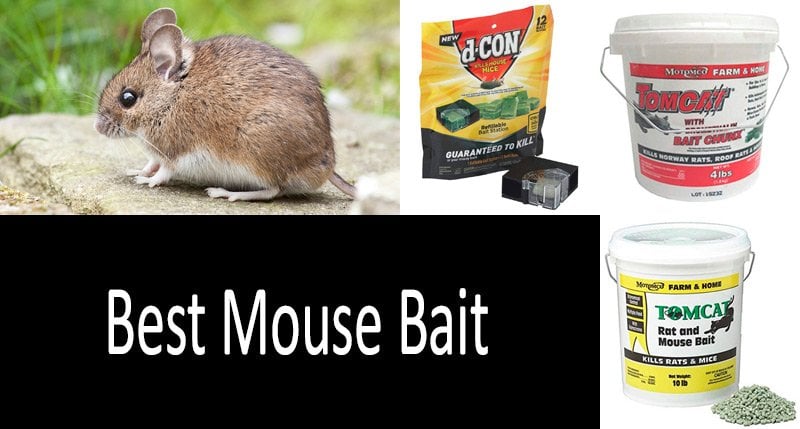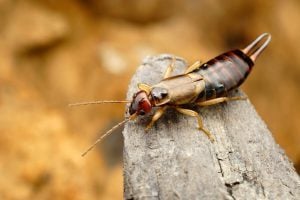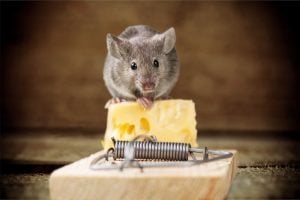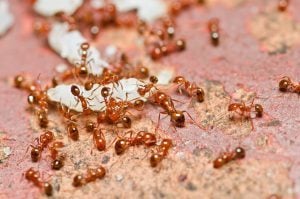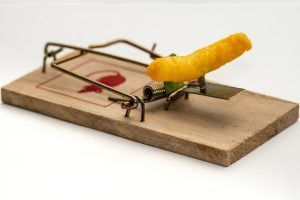What is the best mouse bait? There are four types of these poisons: slow-acting and fast-acting poisons that prevent the blood from clotting, baits that affect the rodent’s nervous system, and those increasing calcium levels in the blood. The slow-acting poisons require multiple feedings, contain lower concentrations of active ingredients, and are believed to pose a lower risk to humans and animals, should they accidentally consume the poison. The fast-acting baits are more toxic and kill a rodent after a single feeding. Mice can avoid some tastes or smells. To overcome bait shyness, change the type and taste of baits periodically.
|
Tomcat Bait Chunx Pail 4 LB. |
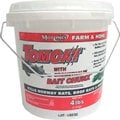 Check the current price |
|
JT Eaton 166004 709-PN Bait |
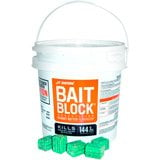 Check the current price |
|
d-Con Corner Fit Mouse Poison Bait |
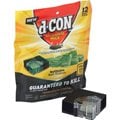 Check the current price |
|
Motomco 008-32345 Tomcat Mouse Bait Pellet |
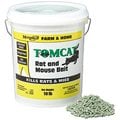 Check the current price |
|
Farnam Just One Bite II Bait Chunks |
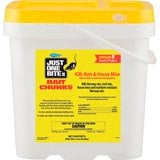 Check the current price |
|
Neogen Rodenticide Ramik Mouse Bait |
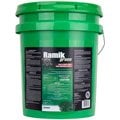 Check the current price |
|
Tomcat Rat & Mouse Killer Refillable Bait Station |
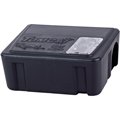 Check the current price |
|
Kat Sense Bait Station |
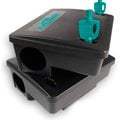 Check the current price |
|
JT Eaton 902 Plastic Top Loader Bait Station |
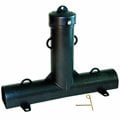 Check the current price |
Fast-Acting vs Slow-Acting Mouse Poisons: What’s the Difference in Action?
Mouse poisons can be categorized by mode of action: baits that kill by preventing blood from clotting and substances that target the nervous system or influence calcium levels in the blood.
Mouse Baits Targeting the Nervous System & Calcium Levels
Basically, these products are based on ingredients like cholecalciferol or bromethalin. Cholecalciferol causes a dramatic increase in calcium levels, which results in heart or kidney damage. Bromethalin, the most common and efficient ingredient in this category, works by interfering with the mouse’s nervous system. This ingredient is used not only in rodenticides but also for poisoning small animals like moles.
One of the most popular products containing bromethalin is the Tomcat Bait Chunx Pail 4 LB. It is recommended for both agricultural and rural settings. After consuming a toxic dose of this poison, mice stop feeding. This makes the Tomcat Chunx not only effective but also cost-efficient as you will need less bait to control mice. The product works well against mice resistant to poisons that work by preventing the blood from clotting. So you can safely use it when other baits don’t bring results. In addition, it kills faster than other types of poisons — in just a couple of days. The blocks are mold- and moisture-resistant and come with multiple edges to attract mice. Low content of paraffin and food-grade ingredients make it very palatable to rodents.
Alternatively, you may buy the d-Con Corner Fit Mouse Poison Bait that includes a bait station and 12 refills. The reusable box is resistant to tampering by pets or children and can be used both indoors and outdoors. You will be able to see the bait through the clear window in the box to monitor the process. Mice will begin to die approximately three days after digesting the poison. The bait is formulated with cholecalciferol, a potent mouse poison that causes permanent damage to the body within a couple of days. At high doses, it dramatically raises plasma calcium and phosphorus concentrations, something that results in soft tissue mineralization and death.
Blood Thinning Mouse Poison Baits
As for blood thinners, there is a variety of active ingredients. What you need to distinguish is between fast-acting and slow-acting baits.
| Type of a Blood Thinner | Pros | Cons |
| Fast-Acting |
|
|
| Slow-Acting |
|
|
Slow-Acting Mouse Baits
Slow-acting or first-generation poisons require mice to feed multiple times to get a lethal dose. Researchers with the University of Nebraska-Lincoln highlight three main ingredients that are used in slow-acting baits: warfarin, diphacinone, and chlorophacinone.
These poisons are considered to be less dangerous in case something other than mice accidentally eats the bait. However, experts from the Children’s Hospital of Philadelphia warn about an implicit threat of slow-acting baits. The delayed effect of poisoning may give you a false sense of security and you may fail to notice that your kid or pet has digested the bait.
What product to choose? Based on diphacinone, the Motomco 008-32345 Tomcat Mouse Bait Pellet is economical and efficient. The 10-pound pail contains moisture- and mold-resistant pellets. The bait requires multiple feedings and typically kills mice in four to six days. The active ingredient, diphenadione, is a vitamin K antagonist that stops normal blood clotting. It has a longer active half-life compared to other poisons of this category, meaning its poisoning effects persist for longer. This is a perfect choice for light to moderate infestations. Place the pellets indoors, in rodent burrows, and hard-to-reach areas.
In fact, you can place this poison anywhere if you use a bait station like the Tomcat Rat & Mouse Killer Refillable Bait Station. The product is tamper- and weather-proof and features a window allowing you to easily check whether the bait was eaten. You can load one or two bait blocks at a time, which is enough for killing several mice. The box can be placed both horizontally or vertically. Position it in the locations where there are signs of mouse activity like droppings as well as in corners, attics, basements, and behind appliances.
Fast-Acting Mouse Baits
Fast-acting (second-generation) poisons kill mice after a single feeding. To prevent bait-shyness, they are typically formulated so that the rodent dies not immediately but rather within a day after consuming the poison. The most efficient active ingredients include brodifacoum, bromadiolone, difethialone, and difenacoum.
You may try the Farnam Just One Bite II Bait Chunks, which is intended for use in and around agricultural buildings. Mice will consume a lethal dose in one feeding and die in 4 to 5 days. The 8-pound pint contains 64 pieces of poison bait with a potent ingredient bromadiolone. The two-ounce chunks have holes for use in a bait station and nibble ridges to encourage mice to try them.
Why are mice not eating poison? How to Prevent Bait Shyness & Bait Aversion
The major problem is that mice develop poison shyness very readily. However, a distinction should be drawn between bait shyness and bait aversion. Bait shyness or neophobia is observed when mice avoid or are cautious toward a new bait in their environment. They may take a few samples of the unfamiliar food to see whether it is safe to eat. To put it another way, bait shyness is a natural behavior of mice.
Bait aversion, on the contrary, is a result of the negative experience of a particular mouse. It is the avoidance of poison by a mouse that has previously consumed that substance. If the toxic effect occurs soon after the bait is digested, the rodent will associate the illness with that food. If the dose wasn’t lethal, the mouse is likely to stay away from the bait in the future. Moreover, rodents that have survived poisoning become more neophobic and cautious toward any kind of food. In a situation where a mouse experiences sufferings or dies immediately after consuming the bait, other mice are likely to avoid the poison, too.
That’s why we recommend to rotate and change the type or tastes of baits periodically, every 4-6 weeks.
What Tastes Attract Mice?
An unpalatable bait will ruin all your pest control efforts. Not only won’t it attract mice, but it can also lead to a bait aversion. So what are their taste preferences? Probably the main reason why rodents have been coexisting with humans for centuries is that they can digest almost anything that we eat. In particular, the diet of mice includes plants, grains, seeds, fruits, berries, red meat, fish, poultry, pet food, oils, salty and sweet treats. Mice enjoy eating nuts for their high-protein content and are known fans of peanut butter. That is why some manufacturers flavor their baits with peanut butter.
For example, this high-rated JT Eaton 166004 709-PN Bait is formulated with diphacinone as an active ingredient and the peanut butter flavor as a powerful attractant. The product comes in a 9-pound resealable pail with 144 bait blocks. After digesting a certain amount of it, the mouse will die within a few days. The manufacturer recommends placing these blocks in the basement or garage.
Another flavor that mice cannot resist is that of fish. The Neogen Rodenticide Ramik Mouse Bait contains diphacinone and is fish-flavored. The poison requires only one feeding to be effective and kills rodents within 5 days. The ingredients are food-grade, so mice just won’t be able to ignore it. Not only does it have an enticing flavor, but it also is rich in protein. A special formula used by the manufacturer allows the bait to retain its freshness and sweetness for a long time. It is weather-resistant and can be safely placed in damp or wet areas.
Additives
Scientific research suggests that certain additives make rodent control much more successful. These are yeast, minced meat, chicken blood, the shell and yolk of eggs. That said, yeast and egg shell additives are the most preferred ones. The study shows that a 2% yeast additive is able to increase bait palatability by nearly 70%.
One of the most effective ways to prevent bait aversion is to add oils to the bait. New Zealand’s scientists have published a study saying that the higher the level of oil in bait, the more readily rodents consume it. Unlike rats, mice prefer high-fat foods, particularly, corn oil and arachis oil.
A good option is the Happy Belly, a 128-ounce bottle of peanut oil with 14 grams of fats per serving. Interestingly, the experts have found out that while groundnut oil is not attractive to rodents by itself, it has the ability to mask the odor of cereals to which rodents have developed bait aversion.
Other measures include covering baits with materials that have been present at the site for quite a long time and mixing the poison with familiar palatable foods. Last but not least, to prevent bait aversion, scientists recommend using multiple-dose slow-acting poisons that contain low concentrations of toxicants.
Baits for Traps: How to Lure a Mouse
Even though poison is placed in a secure bait station, there is still a risk that a child or a pet might find and consume it. That is why many homeowners choose to trap mice rather than poisoning. Nevertheless, this does not eliminate the need for using baits, though non-toxic, to attract mice.
How to lure a mouse in the trap? You can use pantry items like cereals, rice, and oatmeal. However, their favorite food should be fatty and sweet like soft cheese and peanut butter. A piece of chewing gum and marshmallows will also do the job. Also, there are commercial ready-to-use baits, such as the Tomcat Mouse Bait Attractant Gel. Unlike natural foods, this gel remains effective for a long time and is a great alternative to cheese or peanut butter.
What distinguishes baiting traps from poisonous baits is that the former ones do not necessarily have to be eaten to be effective. Your aim is to catch a mouse in the trap, so it doesn’t actually matter whether it has consumed the bait. For this reason, you can even use non-edible baits like a cotton pad. Mice use such items as building materials for their nests and would not miss the opportunity to get them.
Choosing the Right Bait Station
A bait station is a must. Why? First of all, poisons must be out of the reach of children and non-target animals. Secondly, boxes protect baits from dust, moisture, and all sorts of debris. And thirdly, they make baiting more efficient because mice feel more secure in enclosed spaces. But keep in mind that proper placement is crucial to be successful. Choose locations where mice are active, close to their burrows, along mouse pathways, against the walls, and near their food supply.
Bait stations designed for mice are smaller than those intended for rats. According to the University of Missouri scientists, a good mouse bait station should have entrance holes about 1 inch in diameter. Apart from the size, these products also differ by the type of bait they can hold. Some models can contain only solid baits like those made from grain, while others are intended for liquid only. There is a third option, though. If you plan to alternate baits based on different substances, the best choice for you will be a versatile station that can hold both solid and liquid baits.
Bait stations can be made from cardboard, metal, or plastic, with the latter being the most common type of material. To meet safety criteria, manufacturers use sturdy materials and a two-chamber design. There are also tamper- and weather-resistant boxes for outdoor use and others capable of holding mouse traps.
The Kat Sense Bait Station is designed specifically for outdoor use and is safe for children and non-target animals. It features 2-inch entry holes and double-key locking lids. The metal bars hold the poison securely so that it does not fall off. Made from sturdy polypropylene, the box is tamper-resistant and withstands exposure to extreme temperatures and weather conditions. The product comes with mounting brackets, which makes it both safer and more efficient. When mounted, the bait station cannot tip over or be carried away. Moreover, you can mount it to the wall along the mouse runways to achieve better results. Each pack contains a set of two bait stations.
Expert Opinion: Franklin Hernandez, Certified Pest Control Operator

Franklin Hernandez, Certified Pest Control Operator
Franklin Hernandez is a certified pest control operator for household, lawn, and ornamental pests with 10-year experience. He has also received training as a horticultural specialist at Miami Dade College. At present, Franklin is the owner and operator at Nature Pest, a company that provides natural, eco-friendly, and organic pest control services in Miami.
What is the difference between an exterior and an interior rodent stations? And why should it matter? The fact is that the federal law requires that any station placed outside a building with rodenticide bait must have a weight on it to prevent a child or a pet from being able to tip it over. What you mostly are familiar with are these types of stations that you can use indoors with poison. But you can’t place these outside because they don’t weigh much and a child can tip it over or turn it backward. The bait can fall out and the child can eat it. These stations also have a federal requirement that they can not be placed more than 100 feet away from a building or a structure. You have got to make sure that if you are going to use these that your state allows you to do your own rodent control… This is an exterior rodent station that has this huge weight, it weighs probably about 8-9 pounds. And this one comes with a secure key, so a child can’t open it without a key.

